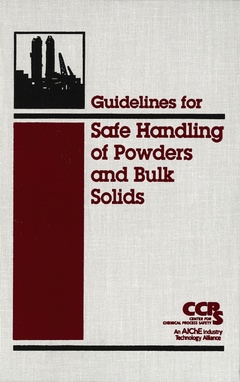Guidelines for Safe Handling of Powders and Bulk Solids (CCPS)
Auteurs : GROSSEL Stanley S., GALOSH

1. Introduction and Overview.
1.1 Purpose of Book.
1.2 Particulate Hazards.
1.2.1 Combustibility Hazards.
1.2.2 Instability Hazards.
1.2.3 Reactivity Hazards.
1.2.4 Toxicity Hazards.
1.3 Accident Data and Case Histories.
1.3.1 Dust Explosion Data and Case Histories.
1.3.2 Other Particulate Incident Databases.
1.3.3 Sample Case Histories for Particulate Instability, and Reactivity Incidents.
1.4 Particulate Handling and Storage Equipment Hazard Overview.
1.5 Historical and Regulatory Perspective.
References.
2. Particulate Characteristics and Properties.
2.1 How Particulate Characteristics and Properties Affect Hazards.
2.2 Particulate Physical Characteristics.
2.2.1 Size Measurement Methods.
2.2.2 Particle Size Distribution.
2.2.3 Filter Characteristics.
2.2.4 Flake Characteristics.
2.2.5 Abrasiveness.
2.2.6 Hardness and Friability.
2.2.7 Agglomeration.
2.2.8 Particle Size Changes due to Friability and Agglomeration.
2.2.9 Bulk Density Measurements and Characterizations.
2.2.10 Dust Cloud Concentration Measurements.
2.2.11 Bulk Powder Moisture Measurements.
2.2.12 Fluidity and Dispersibility.
2.2.13 Electrical Resistivity.
2.3 Overview of Particulate Chemical Characteristics.
2.3.1 Flammability and Explosibility.
2.3.2 Thermal Degradation and Instability.
2.3.3 Chemical Reactivity: Incompatible Chemical Groups.
2.3.4 Corrosivity.
2.4 Overview of Particulate Toxicity.
2.4.1 Particulate Properties Pertinent to Respiratory Hazards.
2.4.2 Allergenic and Irritant Materials.
2.4.3 Systemic and Single Exposure Toxicity.
2.4.4 Carcinogenic Classifications.
References.
3. Particulate Hazard Scenarios and Examples.
3.1 Thermal and Shock Instability Scenarios.
3.1.1 Exothermic Decomposition Explosions.
3.1.2 Shock/Friction Sensitive Instability Scenarios.
3.1.3 Self Heating Hazard Scenarios.
3.2 Decision Trees for Assessing Thermal Instability Hazard Scenarios.
3.3 Chemical Incompatibility Hazard Scenarios.
3.3.1 Contamination Hazard Scenarios.
3.3.2 Water Entry Scenarios.
3.3.3 Container/Packaging Incompatibility Scenarios.
3.3.4 Air Access to Pyrophoric Particulates.
3.4 Chemical Compatibility Charts for Assessing Hazards.
3.5 Particulate Fire Scenarios.
3.5.1 Smoldering Fires in Storage Piles and Dust Collectors.
3.5.2 Dust Layer Fires.
3.5.3 Waterhouse Storage Fires.
3.5.4 Particulate Flash Fires.
3.6 Decision Trees for Assessing Particulate Fire Scenarios.
3.7 Dust Explosion Scenarios.
3.7.1 Primary Dust Explosions in Process Equipment.
3.7.2 Hybrid Explosion Scenarios.
3.7.3 Explosion Propagation to Connected Equipment.
3.7.4 Secondary Dust Explosions in Building.
3.8 Dust Explosion Decision Trees and Protection Flow Charts.
3.9 Toxic Material Exposure Scenarios.
3.9.1 Chronic Exposure Scenarios during Processing and Material Handling.
3.9.2 Acute Exposure Accident Scenarios.
3.9.3 Fire and Explosion Exposure Scenarios.
3.9.4 Incident Cleanup Exposure Scenarios.
References.
4. Assessing Particulate Hazards.
4.1 Preliminary Assessment via Material Safety Data Sheets, Handbooks, Guidelines, Codes, and Standards.
4.1.1 Preliminary Assessment of Instability Hazards.
4.1.2 Preliminary Assessments of Reactivity Hazards.
4.1.3 Preliminary Assessments of Combustibility...
Date de parution : 06-2005
Ouvrage de 796 p.
23.7x16.1 cm
